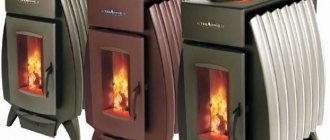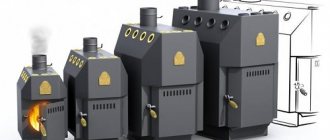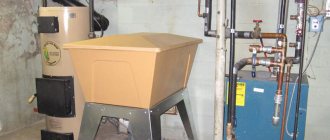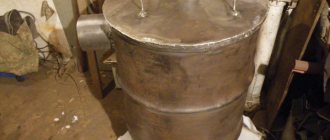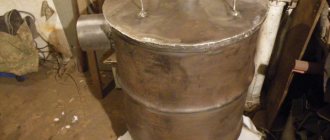A boiler for greenhouses is the equipment that will allow you to get a good harvest even in severe frosts. Everyone knows how much vegetables cost in winter, so bringing your own vegetables during this period is a very profitable solution. But every vegetable grower who decides to start heating a greenhouse may face the difficulty of choosing a boiler, because there are several varieties on the market. Which one should you choose for this or that site? Or maybe it would be easier and cheaper to make it yourself from scrap materials?
Boiler options for greenhouses
At the moment, the following boilers for greenhouses are widely used:
- wood;
- combined (wood-coal);
- pellet;
- gas;
- electric.
Conventionally, they are classified into two more subspecies. Solid fuel boilers are the first three types above. Long-burning boilers are included in a separate category, since the principle of their operation is not based on the combustion of materials, but on their smoldering, for which a system of controlled oxygen (air) supply is used. They are the most effective and economical, but are quite expensive.
The simplest heating boilers for greenhouses are gas and electric. However, it is impossible to call them economical and profitable in the current situation. Gas and electricity are already too expensive for heating, and further price increases are expected in the future. Therefore, such boilers are used only for emergencies, when other heating options are simply unavailable for some reason.
You can cook a wood-burning boiler yourself, but it will turn out to be a banal potbelly stove. Its advantages are low cost and efficiency, but its disadvantages are the inability to regulate the temperature, the need to constantly add fuel (wood or coal), as well as uneven heating of the greenhouse area. Their use will be justified only if we are talking about a polycarbonate or glass greenhouse with steam heating (or where the pipes are laid in the ground at a depth of about 50 centimeters). And such a boiler for heating a greenhouse is suitable only for small areas. If the greenhouse occupies more than 50 square meters, then several “bourgeois” will be required. Keeping track of them is extremely difficult and troublesome.
But there is also a very big advantage for wood-burning boilers and long-burning boilers for solid fuel greenhouses. The product of their waste is ash and ash, which are extremely useful “ingredients” for growing any vegetable and fruit crops. And in the case of beets, for example, ashes allow you to get rid of any insect pests and thereby save a considerable amount on the purchase of agrochemicals (pesticides and mineral fertilizers). For a vegetable grower, this is not the least advantage.
Do-it-yourself stove for a greenhouse: stages of creation
A DIY greenhouse stove will save your money. And in terms of efficiency it will be similar to the purchased one.
Let's look at creating a furnace using a barrel as an example:
Take a metal barrel. Cut off the top of the lid. We make a groove in the barrel. We weld the chimney. We cut individual doors in a metal barrel in order to place flammable material. We create a blower. We cut a hole in the center of the lid and weld another pipe. This is done for the purpose that the fuel smolders during operation of the stove. At this time, the lid goes down due to its weight.
In order for a homemade stove to work correctly, you need to insert a cone-shaped pipe into the inside of the upper barrel. You need to insert it so that the narrow part fits a couple of centimeters into the hole in the partition. The space around the pipe should be filled with dry sawdust.
Which boiler to choose for a greenhouse
When choosing a boiler for heating greenhouses, you need to take into account both the area of the heated room and your financial capabilities. Ideal - long burning, but they cost an average of 100 thousand rubles. But their consumption is 2 styling for 24 hours. In large greenhouses, they completely pay for themselves in just 1-2 seasons (if the firewood or coal is purchased). In small ones, with an area of about 15-20 square meters, the payback will stretch over almost 10 seasons.
For the latter option, simple solid fuel heating boilers or those that run on gas would be ideal. The efficiency of the system will be significantly higher if it is supplemented with a pump for pumping water through pipes. This, by the way, will ensure uniform heating of the heated room.
An electric boiler, as practice shows, is a pointless waste of money. They are inefficient, use too much electricity, and only increase the temperature at the top of the greenhouse. The volume near the ground remains cold, which leads to freezing of plants.
Combined long-burning boilers are classified as industrial boilers.
They should be purchased only if the greenhouse is over 100 square meters and crops that react extremely sharply to changes in microclimate are grown in it.
These are, for example, bell peppers, strawberries, strawberries, raspberries, eggplants, carrots, potatoes. They cost accordingly - from 200 thousand rubles. But the savings are huge! And boilers of this type also operate on liquid fuel (meaning recycled oil, fuel oil, oil industry waste).
A few words need to be said about the pyrolysis boiler, which is conventionally a derivative of long-burning solid fuel. Its operating principle is based on burning wood gas. It has very high heat transfer, since a flame is supplied through the nozzle as if from an autogen, thereby quickly heating the water tank. The heat can be dissipated into a steam heating system or by a fan through a radiator. Such a boiler is both productive and economical, but it occupies quite a large space (including in height). Not suitable for small greenhouses, as they can burn plants. The landing distance from the boiler is at least 50 centimeters.
Soil heating system from convectors
Convectors are good for everyone, but they cannot solve the problem of heating the earth. There is, of course, a way out - to lay pipes and blow warm air through them, but these are complex systems that are developed by professionals. You can build a similar simple homemade system using any unit: dig a hole, install a stove with a convector casing in it. You lay the chimney in the ground parallel to one of the walls and take it outside the greenhouse and only lift it up there.
Heating of both air and soil with one convection oven
The idea is simple but effective. Firstly, the air and adjacent soil around the stove are heated by thermal radiation emanating from the body (it must have a convection casing, which will provide an intense upward air flow along the walls). Secondly, combustion products, passing through a chimney located in the soil, warm it too. But problems may arise with the selection of material for such a pipeline: it should not have too good a heat transfer, otherwise the soil will become hot. In addition, these pipes must be sealed - you can’t joke with combustion products - you can get caught. They must also withstand high temperatures - at the boiler outlet the smoke temperature can be 350°C or higher (depending on the boiler and the type of fuel used). Asbestos pipes are more or less suitable for inexpensive materials, but they cannot be called environmentally friendly and require care with sealed connections.
This solution also requires the presence of a smoke exhauster in the pipe - a long horizontal section of the pipe does not at all contribute to the presence of draft. Therefore, a smoke exhauster is required and its power must be decent. It needs to be installed closer to the end - the temperatures there will be lower and it will work longer. But during installation, it is necessary to provide for the possibility of frequent cleaning - soot will accumulate: with a vertically located chimney, it mostly flies away, and in our version it is deposited on the pipes and blades of the smoke exhauster. The pipes will also need to be cleaned frequently, so some kind of inspection windows are needed here too. In general, it is problematic. But if you build a couple of such pipelines, you will be able to heat your greenhouse economically.
Types of boilers for solid fuel greenhouses
There are three types of most convenient devices for use in greenhouse conditions:
- direct combustion units;
- pyrolysis boilers;
- long burning devices.
Pellet and wood direct combustion
Direct combustion solid fuel boilers are a classic example of a stove. Their device is extremely simple - most often it is a combination of a combustion chamber, a chamber for accumulating ash and a chimney.
Installation and operation of such a device will not cause any problems . The boiler emits heat when burning wood with high humidity, dry wood, coal, peat briquettes, pellets.
Often, heating elements are connected to such boilers to operate on electricity , or a water heating system . It all depends on the specific model.
The advantages of such devices include price . Due to the simple and understandable design, as well as the absence of multiple electronics, such a boiler is not too expensive. The device will not depend on the availability of gas and electricity. So if there is a power outage somewhere, the unit will not stop functioning.
The need to store a large supply of fuel is one of the disadvantages of the design. Wood, peat and other heat sources are not the cheapest materials, and you will also have to pay for their periodic delivery. It will be necessary to allocate space for storing “firewood”, because not all models can accept raw materials.
Pyrolysis
Pyrolysis boilers, also known as gas generator boilers , operate on a different principle. If a standard unit burns solid fuel, releasing soot, coke and ash into the surrounding space, then a pyrolysis boiler burns not only the wood itself, but also the gas that is released from the wood under high pressure and temperature. Subsequently, the gas is driven through a special nozzle, at the exit of which the flame is close to white.
The milky color of the fire indicates a fairly high combustion temperature , therefore, the efficiency of the same amount of firewood used in a pyrolysis device and a direct combustion boiler will be completely different. Thus, the gas generating unit is head and shoulders above its predecessor.
Photo 1. Comparison of the structure of a direct combustion solid fuel boiler (left) and a pyrolysis boiler (right).
Pros: Boiler efficiency. You can get much more heat from the same volume of fuel, therefore, the cost of the fuel itself will be somewhat lower, which will allow the device to pay for itself. The environmental friendliness of this unit will be approximately three times higher than that of a direct combustion design, since water vapor mixed with carbon dioxide is released into the atmosphere.
The disadvantages include the price. It can scare off an inexperienced user: the simplest units cost at least 30 thousand. But the price of such devices is justified, and over time the device pays for itself due to fuel savings.
Long burning on wood
These devices can be either pyrolysis or direct combustion . The average operating time of a long-burning pyrolysis boiler is about 8-10 hours on one stack. For full heating of the greenhouse, two bookmarks per day are enough. When the boiler goes out, the generated heat circulates in the room for some time. Therefore, if the greenhouse is thermally insulated, the temperature will drop much more slowly.
A direct combustion boiler differs from a standard unit. The main difference is in the patented combustion and air supply system, in which the top layer of firewood burns, constantly falling down. On one stack of wood, such a boiler will work for about 30 hours. On hard coal - up to 7 days.
Pros: Very big savings on fuel. No type of boiler can compare in terms of performance with this unit.
There is no need to constantly monitor the temperature in the greenhouse and add firewood to the firebox.
Cons: Price, however, any amount paid for this boiler will pay for itself very quickly.
Step-by-step installation instructions for Bubafoni
This stove, whose name comes from the nickname of its author on one of the forums, has two small drawbacks. As a matter of fact, the first of them - unsightly appearance - is not particularly a minus, because it needs to be installed in a greenhouse, and not in a house. But the second is a high fire hazard (pyrolysis temperature reaches 350 degrees), and it must be treated very carefully by organizing a fireproof foundation and installing a protective screen or casing.
Autonomous stove from an old barrel
Simplified calculation of the basic dimensions of the heater
To begin with, it is worth deciding what is best to make the body from: this depends not only on the availability of this or that material, but also on the required duration of operation of the furnace with one load. A load of solid fuel in the Bubafon from a gas cylinder burns for about 5 hours, and the body from a 200-liter barrel allows you to “forget” about heating the greenhouse with wood for at least 12 hours.
A homemade stove consists of several components, the dimensions of which, if you want to achieve the highest power ratings, are recommended to meet several requirements:
- A metal case is optimal if its diameter is in the range of 300–600 mm, and its height is in proportion to it in the proportion from 1:3 to 1:5.
- Distributing disk - the gap between it and the furnace wall should be 5% of the diameter (for example, with an internal furnace circumference of 400 mm, the diameter of the disk is approximately 360 mm).
- Air ducts (their role can be sections of a channel, angle or steel strip) - with an internal diameter of the body of 300 mm, the height of their ribs should not exceed 40 mm, with 800 mm - 80 mm.
- Exhaust chimney pipe - its cross-sectional area is calculated using rather complex formulas, but for a long-burning stove made from a gas cylinder (300 mm in diameter and 850 mm in height), it is equal to 175 cm2, respectively, the diameter of the pipe is 150 mm.
- Air supply channel - a pipe with a cross-section of 80 mm and a height exceeding the height of the cylinder by 7-10 cm is suitable for its arrangement.
Structural components of a stove for a greenhouse
Of course, these parameters are recommended and not mandatory, but their theoretical calculation in practice leads to a significant increase in efficiency.
Arrangement of the furnace body and piston assembly
The algorithm for preparing and installing units is as follows:
- Cut off the top part of the cylinder and weld a handle and stops to it to secure the lid to the body.
- To make a piston, cut a hole on a metal pancake according to the diameter of the air supply pipe.
- On one side of the pancake, weld 5-6 strips of air ducts from a channel or corner; for a more uniform distribution of air, it is better to first bend them with a screw.
- You can weld another, only smaller diameter, metal pancake with a hole in the center directly to the air ducts by welding.
- Weld the air supply pipe to the almost finished piston, additionally strengthening it with stiffeners.
- In the upper part of the body, just below the lid, cut a hole for installing the chimney and weld a horizontal section of the chimney no more than 400 mm long into it with maximum tightness.
- Raise the chimney pipe vertically to a height of 4–5 m - this will ensure high-quality draft.
Oven ready for installation in a greenhouse
It is better to make the chimney dismountable, and it should be assembled from the roof. As an option, an inspection glass can be built into the pipe so that its condition can be monitored and cleaned without dismantling.
Assembling all the parts does not take much time and effort: to do this, place the cylinder-housing on a flat area, load it with fuel (not higher than the level of the chimney duct), install a piston disk on top and close the entire structure with a lid.
Fuel
Fuel is one of the most important issues when equipping a greenhouse with a solid fuel boiler. The main “suppliers” of heat are:
Firewood
The standard requirement for firewood is that it must be dry. Some direct combustion boilers can use raw wood as fuel, but this will reduce the efficiency of the unit. This, in turn, increases the amount of fuel burned.
Attention! For all types of boilers, it is necessary to use firewood from birch, aspen and other species that do not contain resin . During the combustion of coniferous wood, resin particles settle in the chamber and chimney.
Stove heating
If you heat the greenhouse yourself, then you can significantly reduce your costs. One of the economical ways to heat a greenhouse is to install a stove. A simple design can be made independently, the financial costs in this case will be minimal.
To make heated greenhouses with your own hands, you need to follow the instructions given:
- first, in the vestibule of the greenhouse, the furnace firebox is laid out of brick;
- a chimney is laid along the entire length of the structure;
- then the chimney is removed from the greenhouse on the opposite side so that the heat remains in the room and the combustion products come out. The distance between the firebox and the end side should be at least 25 centimeters, and between the top part and the bed with plants - at least 15 centimeters.
There is a second way to install heating in a greenhouse. To do this, you will need a large barrel - its volume must be at least 3 cubic meters. To prevent the container from rusting, the inside is painted with two layers of paint. Holes are made in the barrel. One of them is intended for the chimney, and the others for the tap and expansion tank. Next, a welded stove is inserted into the barrel, a chimney is brought out, and a pipe approximately 5 meters long is installed outside (read also: “Heating a greenhouse with wood is a classic of the genre”). Then an expansion tank with a volume of 20 liters is attached to the barrel - it is welded from sheet metal. A heating system is welded from a profile pipe measuring 40x20x1.5 centimeters. The pipes are laid on the ground so that there is a distance of 120 centimeters between them. This arrangement of pipes will allow the soil to warm up. To ensure water circulation in such a heating system, a special pump will be required.
Factors for choosing a solid fuel boiler
Before equipping a room with a boiler, you should consider some points:
- Climate zone. Since the greenhouse is heated in the winter months, it is necessary to consider the statistics of previous years and clarify the average temperature in each month. This will allow you to see the extremes of temperature fluctuations and select the most profitable option for the boiler and fuel.
- Greenhouse material. If the main light-transmitting material is a simple film, then the plants will not survive extreme cold, no matter how actively the boiler works. If glass or polycarbonate is used, then the chances of getting a harvest are much greater.
- Fuel availability. If the nearest coal mine is hundreds of kilometers away, then using coal as the main fuel can be economically expensive. In addition to the cost of the product itself, logistics costs will come on top, and the price may be higher than that of gas and electricity.
- Room area. A large greenhouse ( approximately 400 sq. m. ) will require either one powerful boiler or two. If the partitions are transparent, then it is better to take two devices to optimally maintain the temperature on the outskirts.
Air heating
This method is also quite simple, and it does not require financial costs. First, take a piece of iron pipe 2-2.5 meters long and 50-60 centimeters in diameter. Then one end of the pipe is inserted into the greenhouse, and a fire is lit under the other. The air in the pipe will warm up quite quickly. This method is quite suitable for maintaining a comfortable temperature in a greenhouse. The main disadvantage of this heating method is that the fire must be constantly maintained. If the fire goes out, the temperature in the greenhouse will drop very quickly. Therefore, such heating of a greenhouse is not common.
Calculation of requirements for technical characteristics, greenhouse heating scheme
The first thing you need to pay attention to is the area of the greenhouse. The second is the presence or absence of insulation in the heated room. Third , there is time to control the maintained temperature and load fuel into the boiler. Fourth - budget.
Photo 3. Greenhouse heating scheme using a solid fuel boiler and a water circuit.
Based on these requirements, you need to select both the device and the fuel for it . With a small budget for a small greenhouse with thermally insulated walls, a direct combustion boiler is quite suitable.
For rooms of 100-150 sq. m with insulation, and also with an average budget, a simple pyrolysis boiler will do.
A long-term burning device is suitable if you have good initial capital and a large area ( about 400 sq. m .) with insulated walls. In this case, minimal effort will be enough to maintain the temperature regime.
Buleryan stoves
Buleryan is a convection heating device that supports the function of long-term combustion. This is not the most common option for heating greenhouse premises.
Attention! Products of the Breneran brand are completely similar in design and technical parameters to Buleryan.
This heating unit combines the functions of three devices at once - a stove, a heater, and a gas generator. Structurally, it is a barrel-shaped metal container with a two-tier firebox. The main feature is the piping of convection pipes curved towards the center of the firebox. The operating principle is common to long-burning generators. In one firebox, gas is produced when wood smolders. In the second tier of the combustion space, afterburning occurs. The design also includes a door for loading fuel, a damper for the chimney, and a draft regulator.
The easiest way to have a beautiful front lawn
You've certainly seen the perfect lawn in a movie, on an alley, or perhaps on your neighbor's lawn. Those who have ever tried to grow a green area on their site will no doubt say that it is a huge amount of work. The lawn requires careful planting, care, fertilization, and watering. However, only inexperienced gardeners think this way; professionals have long known about the innovative product - liquid lawn AquaGrazz .
Features of heating greenhouse premises
The main factor in choosing a heating method for greenhouses is the price of maintaining the temperature. After all, most greenhouses have enormous heat loss. Ideally, for good plant growing, the greenhouse should be built from metal profiles and plastic, with hermetically sealed double-glazed windows.
But most vegetable growers and farmers cannot afford this method of construction, so most domestic greenhouses are covered with polyethylene or polycarbonate. These materials are transparent to sunlight, but also release a large percentage of heat into the surrounding space, so heating the room must be well thought out and powerful.
Boilers for greenhouses
After building the greenhouse, it is necessary to begin creating a heating system, the central element of which will be the boiler. The most commonly used:
- Electric ones are simple, easy to use and available wherever power lines are installed. But using such a boiler to heat a greenhouse will cost a pretty penny, and now rolling or emergency blackouts are common, and then young plants can die from the cold.
- Gas - a stable supply of natural gas ensures good heating of the room, but the price of this energy resource is also quite high. Although many farmers use gas boilers to heat greenhouses because they are easy and quick to maintain, you only need to pipe gas into the greenhouse once and connect the boiler - and the problems are solved. Regulating and maintaining the desired temperature is easy and simple, and the efficiency of gas heating has been proven for years. Often, greenhouses are heated with gas by those whose premises are located next to a gasified house.
Heating a greenhouse with gas
The gas heating system for greenhouses is quite popular. It is not recommended to supply gas from the house to the greenhouse - it will be too expensive. It is better to buy several gas cylinders - they should be enough for the winter (read: “How to heat a greenhouse in winter”). This option will be much more economical. When using such equipment, it should be taken into account that the combustion products of natural gas do not have the best effect on plants. For this reason, it is necessary to make ventilation and exhaust in the greenhouse to remove them outside.
When purchasing a heating device, you should pay attention to the fact that it has a special sensor. It is needed so that if combustion stops, the gas supply to the burner is immediately shut off.
